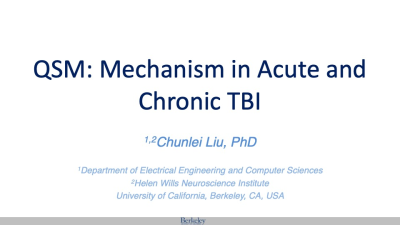Weekday Course
Which MRI Contrast for TBI Assessment?
ISMRM & ISMRT Annual Meeting & Exhibition • 04-09 May 2024 • Singapore

| 08:15 |
DTI & Beyond: Exploring the Microstructure in Brain Trauma
Ante Zhu
Keywords: Neuro: Brain, Contrast mechanisms: Diffusion, Contrast mechanisms: Microstructure During a head impact, brain tissues deform due to the force act on the skull. The shearing and stretching of brain tissue structures affect both the function and connectivity of the brain. Diffusion MRI is highly sensitive to structural changes at the microscopic level. This lecture will introduce the microstructure changes associated with traumatic brain injury and how diffusion tensor imaging can probe them. Cutting-edge diffusion-MRI based microstructure imaging techniques and their emerging role in the study of brain damage will also be discussed. |
|
| 08:45 |
 |
QSM: Mechanism in Acute/Chronic TBI
Chunlei Liu
Keywords: Neuro: Brain, Contrast mechanisms: Electromagnetic tissue properties, Neuro: White matter Quantitative susceptibility mapping (QSM) is a computational technique that calculates voxel-wise magnetic susceptibility values, typically based on the phase images of gradient-echo MRI data. Magnetic susceptibility values of brain tissues can be paramagnetic (i.e. positive) or diamagnetic (i.e. negative) depending on molecular and cellular composition of the tissue. As a result, magnetic susceptibility of brain tissue can be changed by traumatic brain injury (TBI), both in the short term and the long term. This course will discuss the molecular and cellular mechanisms underlying these alterations. |
| 09:15 |
MRS: Imaging the Metabolic Changes in Brain Trauma
Jae Mo Park
Keywords: Neuro: Brain, Contrast mechanisms: Spectroscopy, Contrast mechanisms: Hyperpolarization Hyperpolarized carbon-13 (13C) MRI provides unprecedented in vivo imaging opportunities to assess critical metabolic pathways by imaging both the injected substrate and its metabolic products. This technique with 13C-labeled pyruvate can assess aberrant pyruvate metabolism in the brain by measuring produced 13C-lactate and 13C-bicarbonate in TBI. Studies with hyperpolarized pyruvate demonstrated an acute increase in 13C-lactate production (hyperglycolysis) and a decrease in 13C-bicarbonate production (mitochondrial dysfunction) from a rat TBI model. In parallel, mild TBI patients showed similar observations. These results demonstrate the feasibility and exciting opportunities of hyperpolarized 13C-pyruvate to monitor TBI-associated metabolic changes non-invasively. |
|
| 09:45 |
Hybrid PET/MRI: Synergy To Understand Trauma
Damien Galanaud
|
The International Society for Magnetic Resonance in Medicine is accredited by the Accreditation Council for Continuing Medical Education to provide continuing medical education for physicians.